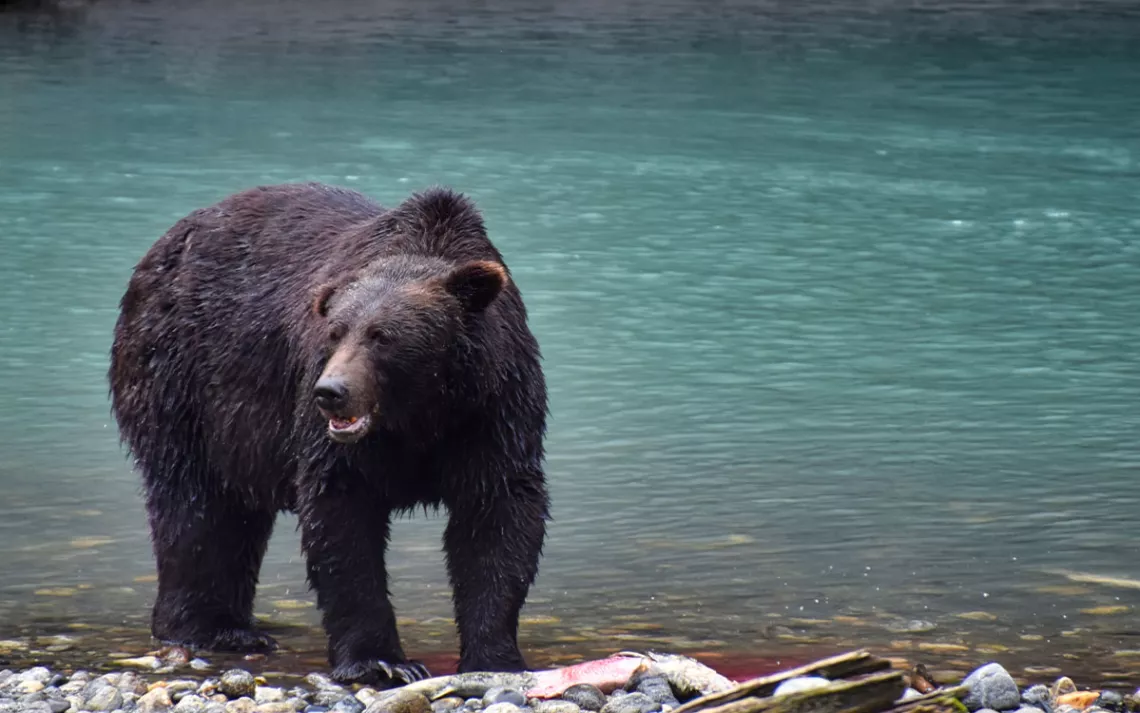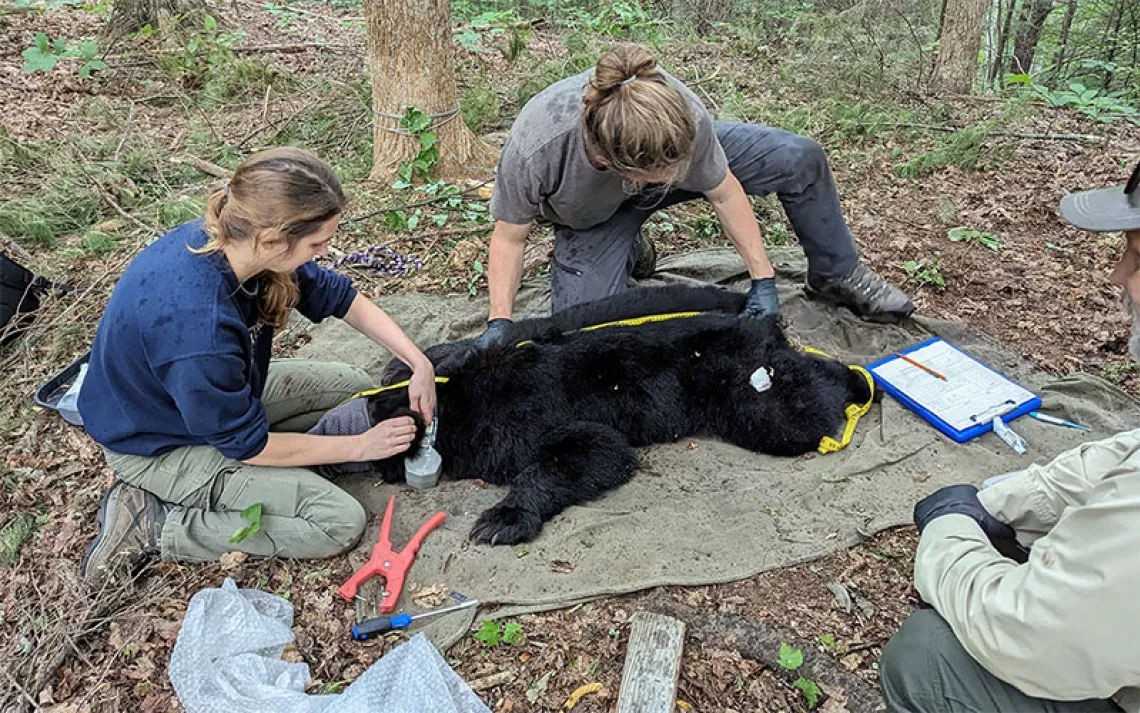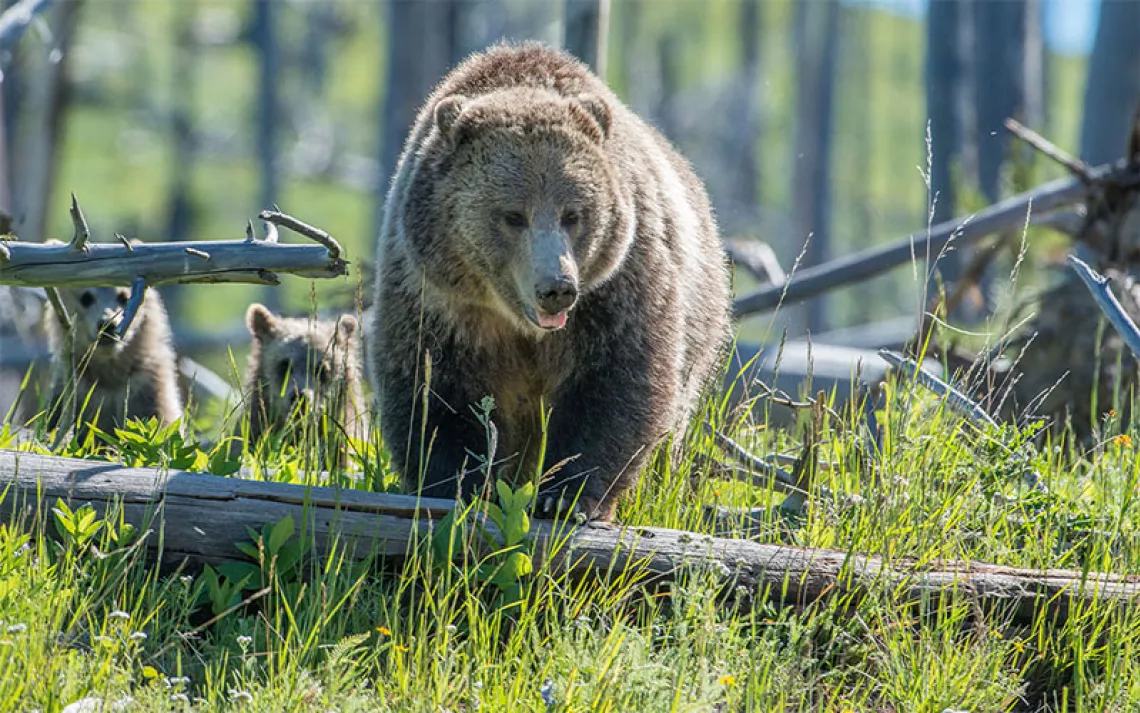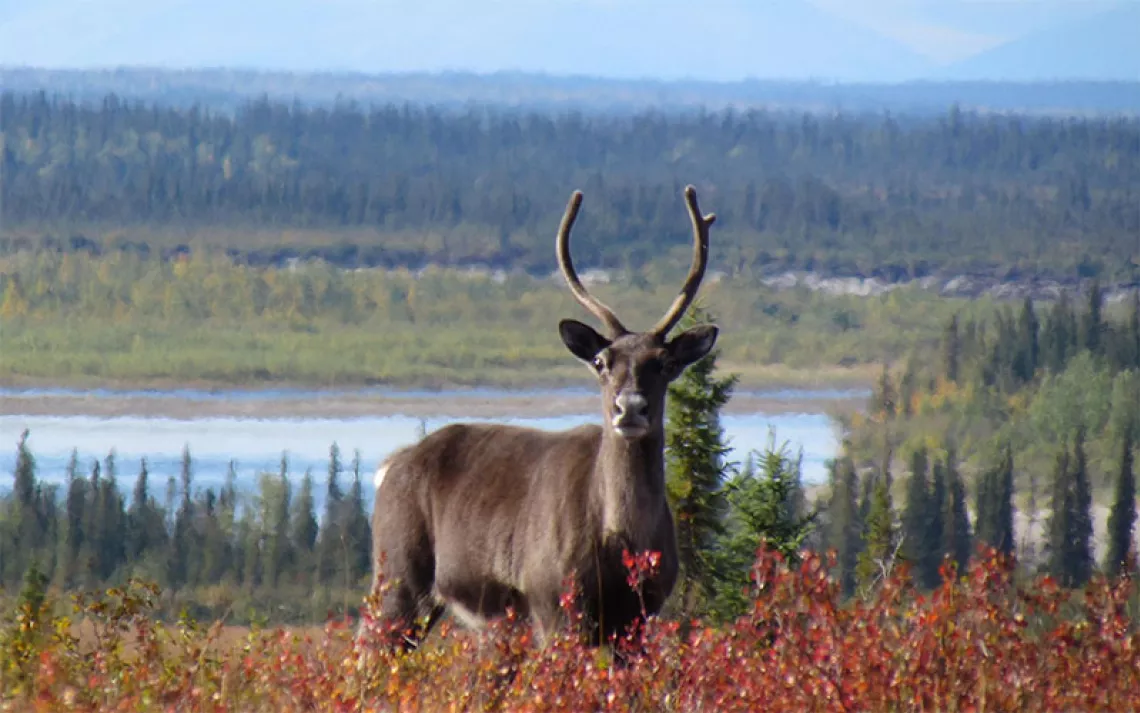How to Safely Photograph Grizzly Bears
A trained Indigenous guide will school you: Carry bear spray and a long lens, and keep your distance.

Grizzly bear during Klahoose bear experience. | Photo by Brandon Withrow
At the end of August, a video circulated of three adult tourists—one carrying a child—at Yellowstone National Park sprinting from their vehicles toward a mother bear and her cubs. It was far from an isolated incident. Every few weeks, the internet brings us another story of park visitors intentionally rushing toward wild bears or bison, hoping to get a highly unsafe selfie.
Viewing and photographing wildlife up close is tantalizing, but there are responsible ways to do it. Remember that the risk is not just to you but also to the animal, since it might have to be euthanized if you provoke it. With potentially dangerous wildlife like grizzly bears, professional guides can help you get the shot and keep you alive while taking it. At the Klahoose Wilderness Resort in British Columbia, Indigenous guides from the Klahoose First Nation provide bear-viewing experiences, part of the burgeoning Indigenous tourism sector in Canada, which now accounts for nearly $2 billion of the country’s GDP.
The Klahoose resort is set along the Homfray Channel between the Salish Sea and the vast coastal wilderness south of the Great Bear Rainforest. For millennia, the Klahoose people have lived with grizzlies (“xawgəs,” in their coast Salish language) and they know how to do it safely. “We give the grizzly bears their space,” said Randy Louie, who works as an Indigenous bear guide and cultural ambassador at the resort. “I mean, we don’t cross their space at all.”
Klahoose’s guides are trained by the Commercial Bear Viewing Association. They are taught best practices developed over 30 years for a low-impact experience that doesn’t stress the bear (key for avoiding a mauling). Louie’s family lives in bear country, so he also knows what to expect from personal experience.
“It was taught to us when we were younger that we shouldn’t cross into areas we’re not allowed to.” It’s one thing to follow a human trail, he said, but if you venture off into the woods on a small trail, you’re likely using a path created by bears or wolves. “If you cross into their path, that’s kind of like letting them know they can cross into your path too,” he added. “So usually, they’ll show signs of aggression—they don’t like to be followed.”
Wildlife viewing and photography is not like watching animals in cages—the outdoors is not a zoo. Our Klahoose guides gave us some basic rules: If we hiked trails around the resort, we took bear spray with us, a self-defense tool to be used if a charging bear is within 20 to 30 feet. Bear spray is statistically safer and more effective than having a gun; 98 percent of those who used bear spray were uninjured by bears in close-range encounters, compared to 50 percent for those with firearms.
Our guides also asked us to not bring food or wear anything scented, to avoid attracting bears. We were told to not approach a bear, surprise it with our presence, or give it a reason to charge—like standing between a bear and her cub (no matter how adorable) or a food source. If you do have an encounter, try to make sure there is a clear exit for the bear, so it doesn’t feel trapped. Try to stay at least 100 yards away. (The same distance rule pertains to wolves, while the common viewing distance for bison, elk, or moose is 25 yards.)
If you want to get closer, let your binoculars or camera lens do the work. (Klahoose makes binoculars available for guests.) I’ve found that 8x32 or 8x42 binoculars work well. If you’re hoping to photograph wildlife, especially bears, camera lenses of 400-600mm will give you a nice shot from a safe distance. Some places might have wildlife blinds set up to allow closer access without stressing the animals.
With a qualified guide leading you into bear country, though, most guesswork is taken out of the equation, and your experience might bring you closer to bears. Bears don’t show up on demand, but a guide will know generally when and where to find them.
At Klahoose, mid-August through October is perfect for grizzly bear observation, as it’s the time of the year when they are fattening themselves up for winter during the annual salmon run. At Klahoose, we met after breakfast to board a boat to the Toba Inlet, just north of the resort. It’s a stunning trip, with tree-filled mountains and islands—and sometimes marine life like whales and porpoises.
After docking, guests were taken by bus on logging roads to six covered observation decks that are perched over rivers. Before leaving the bus, our guides checked to make sure it’s safe. We traveled to the observation platform as a group, which made us look larger, thus deterring a bear from attacking. This kind of observation is not haphazard, and platforms are designed to allow bears to come closer on their own without being stressed. Our voices were kept low, and camera sounds to a minimum. Viewings last for three hours.
When bears show up, it’s a moment that leaves you breathless. We spent our first day closely observing a black-coated mother and her cub (nicknamed "Legs" and "Squawker") fishing in the Klite River. On day two, we were able to spend a significant amount of time with a cinnamon-brown-coated mother and her cub, as well as a black male grizzly nicknamed “Scuba” (because he likes to put his face into the water when hunting). Once guides spotted a bear, they often knew where they might be heading and what observation deck was best to see them, allowing us to get there before the bear arrived. It was a peaceful experience, and at no time did the bears seem stressed or even interested in us.
Wildlife is beautiful and awe-inspiring, and the impulse to see it up close may come from a good place. Done right, the experience can be safe, educational, and camera-worthy.
That way, you get to live to do it again.
 The Magazine of The Sierra Club
The Magazine of The Sierra Club



